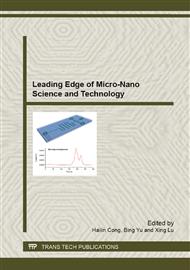[1]
D. Choi, M. Y. Choi, S. W. Kim, et al, Nanoscale networked single walled carbon nanotube electrodes for transparent flexible nanogenerators, J. Phys. Chem. C, 114 (2010) 1379-1384.
DOI: 10.1021/jp909713c
Google Scholar
[2]
Q. Yang, X. Guo, Z. L. Wang, et al, Enhancing sensitivity of a single ZnO micro-/nanowire photodetector by piezo-phototronic effect, ACS Nano, 4 (2010) 6285-6291.
DOI: 10.1021/nn1022878
Google Scholar
[3]
Y. Z. Zheng, X. Tao, J. F. Chen, et al, Novel ZnO-based film with double light-scattering layers as photoelectrodes for enhanced efficiency in dye-sensitized solar cells, Chem. Mater., 22 (2010) 928-934.
DOI: 10.1021/cm901780z
Google Scholar
[4]
J. S. Jeong, J. Y. Lee, C. J. Lee, et al, Single-crystalline ZnO microtubes formed by coalescence of ZnO nanowires using a simple metal-vapor deposition method, Chem. Mater., 17 (2005) 2752-2756.
DOI: 10.1021/cm049387l
Google Scholar
[5]
G. R. Li, X. H. Lu, Y. X. Tong, et al, Electrochemical growth and control of ZnO dendritic structures, J. Phys. Chem. C, 111(2007) 6678-6683.
Google Scholar
[6]
S. Iijima, Helical microtubules of graphitic carbon, Nature, 354(6348): 56-58(1991).
DOI: 10.1038/354056a0
Google Scholar
[7]
K. Biswas, D. Barun, C. N. R. Rao, et al, Growth kinetics of ZnO nanorods: capping-dependent mechanism and other interesting features, J. Phys. Chem. C, 112 (2008) 2404-2411.
DOI: 10.1021/jp077506p
Google Scholar
[8]
J. C. Johnson, H. Q. Yan, P. D. Yang, et al. Single Nanowire Lasers, J. Phys. Chem. B, 105 (2001) 11387-11390.
Google Scholar
[9]
Z. W. Pan, Z. R. Dai, Z. L. Wang, Nanobelts of semiconducting oxides, Science, 291(2001) 1947-(1949).
Google Scholar
[10]
S. Kar, S. Santra, ZnO nanotube arrays and nanotube-based paint-brush structures: a simple methodology of fabricating hierarchical nanostructures with self-assembled junctions and branches, J. Phys. Chem. C, 112 (2008) 8144-8146.
DOI: 10.1021/jp802893t
Google Scholar
[11]
Y. Sun, G. M. Fuge, N. A. Fox, et al, Synthesis of aligned arrays of ultrathin ZnO nanotubes on a Si wafer coated with a thin ZnO film, Adv. Mater., 17 (2005) 2477-2481.
DOI: 10.1002/adma.200500726
Google Scholar
[12]
Q. C. Li, V. Kumar, Y. Li, et al, Fabrication of ZnO nanorods and nanotubes in aqueous solutions, Chem. Mater., 17 (2005) 1001-1006.
DOI: 10.1021/cm048144q
Google Scholar


